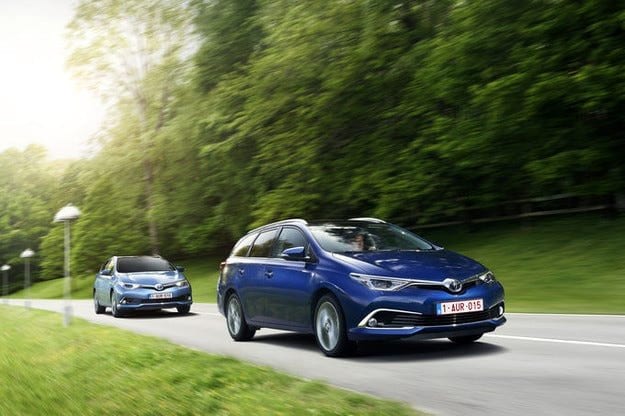
Test drive Toyota Auris: New face

Updated compact Toyota seduces the public with new engines and more comfortable interior
Externally, the modernized Toyota Auris does not show significant differences from the second generation model produced since 2012 and sold in Bulgaria since 2013. However, despite the subtle light, design changes with chrome elements and new LED lights have changed the expression of the front end, which is bolder and more independent. The taillights and modified bumper are in line with current trends in automotive fashion.
However, as you get into the cockpit, the changes not only become more noticeable, they just flood you from everywhere. Compared to the previous version, the dashboard and furniture look as if they were taken from a higher class car. Soft plastics predominate, leatherette with visible seams is used in many places, controls and air conditioning are more elegantly shaped. A 7 '' touchscreen is built into the black lacquered piano frame, and next to it, as a special gesture to fans of Toyota, has an old-fashioned digital clock. reminiscent of other times.
If the seriously updated interior is a kind of counterpoint to the almost unchanged exterior, then it is fully in tune with the innovations that await us under the hood of a compact model. Now here you can find a modern 1,2-compact gasoline turbo engine with direct injection, developing 116 hp. High hopes are pinned on the unit - according to Toyota's plans, about 25 percent of all produced Auris units will be equipped with it. The four-cylinder engine is quiet and almost vibration-free, shows enviable elasticity for its size, and its maximum torque of 185 Nm is in the range from 1500 to 4000 rpm. Acceleration from 0 to 100 km / h takes just 10,1 seconds, and the maximum speed of the Toyota Auris with it is 200 km / h, according to factory data.
Diesel from BMW
Also new is the larger of the two diesel units, a 1.6 D-4D supplied by partner BMW. In terms of quiet ride and even tractive effort, it surpasses the previous two-liter diesel and has a power of 112 hp. and especially the 270 Nm of torque give the updated Toyota Auris a pleasant dynamism and, above all, confidence in overtaking – after all, this engine comes from cars such as the Mini and Series 1. Its standard consumption is 4,1 l / 100 km.
Even less fuel, at least by European standards, is the Auris Hybrid, which continues to be one of the best-selling versions of the model on the Old Continent as a whole. Toyota recently proudly announced that it has sold eight million hybrid vehicles worldwide (of all brands), but only about 500 have been sold in Bulgaria. However, it is expected that about 200 hybrid vehicles will be sold this year. . The transmission of the Toyota Auris hybrid has not changed - the system includes a 1,8-liter gasoline engine with a capacity of 99 hp. (important for calculating vehicle tax!) plus an 82 hp electric motor. (maximum power, however, 136 hp). Not only the hybrid, but all other options already comply with the Euro 6 standard.
This applies, for example, to the naturally aspirated 1.33 Dual VVT-i (99 hp), as well as the redesigned small 1.4D-4D diesel engine with 90 hp. 1,6-liter naturally aspirated unit with 136 hp will remain on the markets of Eastern Europe for some time. which in our country will be offered for 1000 levs. cheaper than the nominally weaker by 20 hp. new 1,2-liter turbo engine.
On a test drive, we drove the new versions of the Toyota Auris on a slightly groomed road and found that both the hatchback and Touring Sports wagon were much more responsive to bumps than previous versions. It seems that even potholes are overcome more gently, the redesigned steering responds more clearly to steering movements and provides more information about the road. If you don't like gear shifting, for 3000 leva you can combine two more powerful gasoline engines with a continuously variable transmission CVT with a seven-speed imitation (there are even shift plates). Overall, the car gives the impression of sufficient dynamics and harmonious settings for a pleasant, relaxing journey.
Toyota Safety Sense Active Safety Assistants, along with a panoramic glass roof and premium Sky LED lighting, also contribute to this peace of mind. It includes frontal collision warning with automatic vehicle stop, lane departure warning, visualization of traffic signs on the dashboard, high beam assistant.
And finally, prices. Their range extends from BGN 30 for the cheapest petrol to almost BGN 000 for the most expensive diesel option. The cost of hybrids ranges from BGN 47 to BGN 500. The station wagon versions are about BGN 36 more expensive.
CONCLUSION
Toyota designers have done a lot to make the Auris a modern, safe, reliable and enjoyable car with a hybrid version that only a Japanese concern can offer. However, other manufacturers are also moving forward and already have quite interesting achievements.
Text: Vladimir Abazov